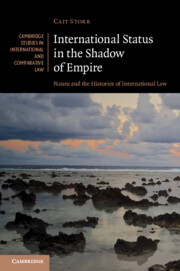Book contents
- International Status in the Shadow of Empire
- Cambridge Studies in International and Comparative Law: 150
- International Status in the Shadow of Empire
- Copyright page
- Contents
- Illustrations
- Acknowledgements
- Prologue
- 1 International Status, Imperial Form: Nauru and the Histories of International Law
- 2 From Trading Post to Protectorate, 1888
- 3 From Protectorate to Colony to Mandate, 1920
- 4 From Mandate to Trust Territory, 1947
- 5 From Trust Territory to Sovereign State, 1968
- 6 After Independence: Sovereign Status and the Republic of Nauru
- Bibliography
- Index
- Cambridge Studies in International and Comparative Law
4 - From Mandate to Trust Territory, 1947
Published online by Cambridge University Press: 20 August 2020
- International Status in the Shadow of Empire
- Cambridge Studies in International and Comparative Law: 150
- International Status in the Shadow of Empire
- Copyright page
- Contents
- Illustrations
- Acknowledgements
- Prologue
- 1 International Status, Imperial Form: Nauru and the Histories of International Law
- 2 From Trading Post to Protectorate, 1888
- 3 From Protectorate to Colony to Mandate, 1920
- 4 From Mandate to Trust Territory, 1947
- 5 From Trust Territory to Sovereign State, 1968
- 6 After Independence: Sovereign Status and the Republic of Nauru
- Bibliography
- Index
- Cambridge Studies in International and Comparative Law
Summary
Chapter 4 traces the accretion of Nauruan administration from 1920 to 1947. According to Article 22 of the League Covenant, C Mandates were to be administered as ‘integral portions’ of the Mandatory’s territory, an ambiguous status that came to pose juridical and diplomatic problems for the League. Australia defended a minimalist interpretation of its obligations in Nauru, as the British Phosphate Commission delivered cheap Nauruan phosphate into the farming sectors of Australia, Britain and New Zealand. For Japan and Germany, however, C Mandate status revealed the hypocrisies of the mandate system. Tensions in the Pacific worsened after their withdrawals from the League in 1933. The chapter revisits Japan’s occupation of Nauru during World War II, the war in the Pacific, and the formation of the UN from 1942. Nauru was re-taken in 1945, and the UN Trusteeship Agreement for Nauru was finalised in 1947, with Australia reappointed as Administering Authority. The chapter concludes that the shift from mandate to trust territory status later proved significant in defining self-government as a trusteeship objective; but that this shift was met with further accretions of imperial form.
- Type
- Chapter
- Information
- International Status in the Shadow of EmpireNauru and the Histories of International Law, pp. 161 - 203Publisher: Cambridge University PressPrint publication year: 2020



